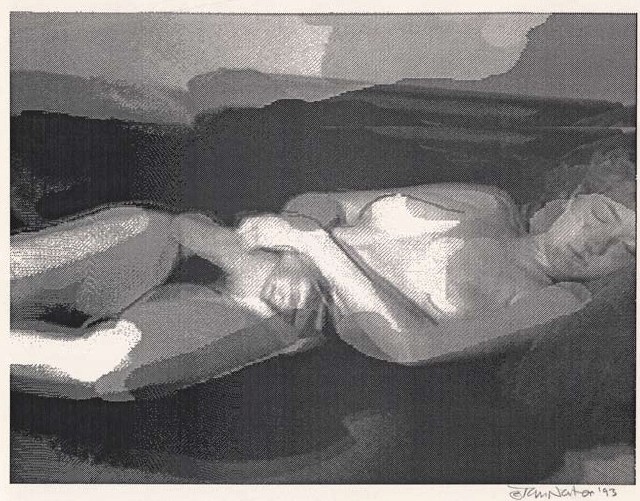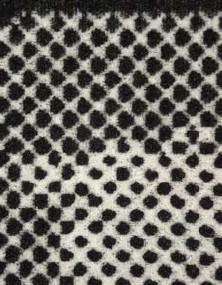- Relief printing
- Intaglio and planographic printing
- Color printing
- Bits and pieces
- Early photography in silver
- Non-silver processes
- Modern photography
- Color notes
- Color photography
- Photography in ink: relief and intaglio printing
- Photography in ink: planographic printing
- Digital processes
- Where do we go from here?
Laser prints

LaserWriter print. Tom Norton. Untitled. 1993. 7 1/16 x 9 1/8" (18 x 23.2 cm). The Museum of Modern Art, New York. Gift of Richard Benson © Tom Norton. Digital devices translate the continuous tone of a photographic image into the on-or-off vocabulary of a printer’s halftone, but the dots typically are much smaller and their patterns can vary considerably. The earliest common digital prints were made with laser printers designed for office use. These machines print fine dots of black toner that can be deployed in bunches to crudely mimic familiar halftone patterns.
The earliest electronically driven prints—that is to say, those directed by an electrical signal rather than by light—were crude images sent through radio or by telegraph to printers that burned their data onto specialized paper. Electronic printing didn’t become really common until the spread of the Xerox machine, invented in the 1920s but not widely used until a couple of decades later. The Xerox made copies by brightly illuminating a document—usually black letters on a white sheet—and using the light reflected from it to create a pattern in a static electric charge on a specially prepared plate. The charge on this plate was used to attract oppositely charged black toner onto a sheet of paper, and that deposit was then set by heat, to make a permanent copy. The sensitive plate was usually cylindrical, and the copy machine thus made could produce readable copies rapidly and cheaply.

Detail of LaserWriter print. Tom Norton. Untitled. 1993. 7 1/16 x 9 1/8" (18 x 23.2 cm). The Museum of Modern Art, New York. Gift of Richard Benson © Tom Norton. The laser printer has very low resolution and its dots can only be printed as a solid black. In this detail we see the coarse halftone generated by clumping the laser dots together. The halftone pattern thus created is about fifty-six dots per linear inch, seen here enlarged ten times from the print.
The Xerox machine underwent a major transformation when new versions were developed that received the image not from a brightly lit sheet but from a binary-driven laser. The light from the laser would dispel the static charge on the plate in any area it struck, and if the beam was finely focused, and turned off and on rapidly, it could lay down a pattern of dots that could form not just letters but also pictures. The letters were built up out of closely spaced black dots—often as fine as 600 per linear inch (this means 360,000 dots per square inch)—but to create the illusion of tone in reproducing pictures, these dots had to be grouped into larger dots, laid down in patterns that emulated the old printer’s halftone.
The new laser-printer halftones were quite crude. When a fine array of dots is used to produce a halftonelike pattern, there is an interlock between resolution and tonal gradation. The easiest way to describe this is to say that a halftone (which the laser could build up out of even finer dots than before) might have a certain number of tonal steps, but a version of that halftone with coarser resolution—say half the resolution—might have as many as four times more tonal steps available to it. This is because the laser can build up halftone dots in a larger number of sizes if it has a larger grid to work in—the fewer the halftone dots per inch, the more dots from the laser are available to build up each one. But a larger grid for each halftone dot means coarser resolution of the halftone. Tonal images printed by laser printers can be highly detailed with limited tonality, or tonally complex with low resolution.

